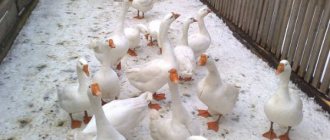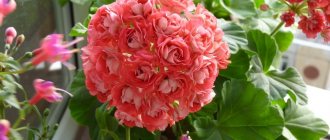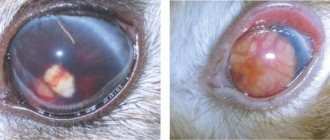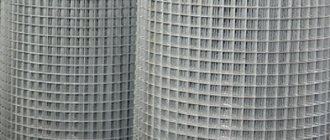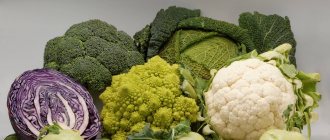What temperatures can rabbits withstand?
Fur warms these rodents well if the air temperature does not exceed -12ºC. In frosts down to -17ºC, a rabbit can survive outside for several days in winter, but prolonged hypothermia is dangerous for it.
In cold winters, when the temperature reaches -30ºC, a rabbit cannot survive without additional insulation. The animal does not have to spend the winter in stone buildings; its immunity is quite capable of withstanding severe frosts. However, you will have to take care to keep the rabbits warm in the cages.
Keeping rabbits in cages
Keeping rabbits at any time of the year, including summer, involves the use of special cages - houses in which the animals will be permanently located. But, if for summer breeding they can be built from any available materials, then cages for winter maintenance should be more reliable.
Note: Despite the fact that these animals tolerate cold well due to their thick fur, it is better to properly arrange their cages in advance for keeping them in winter. If the houses let in the cold, the animals will begin to gain worse live weight.
To keep animals in cages warm and comfortable, we recommend using the following tips:
- It is recommended to raise the houses 80-100 cm above ground level, since most of the cold penetrates inside from the ground.
- A thick layer of bedding must be laid on the floor of the cage, which will act as a thermal insulation layer. The litter needs to be changed every 4-5 days.
- It is better to attach a pallet covered with a mesh with not very large cells to the bottom of the house. This will help keep the cages clean, since in winter feces often freeze before the owner can remove them. If you equip such a tray, feces will accumulate not in the cage, but in the tray, and they can be easily removed.
- The entrance to the cage can be covered with plywood, but it is better to use impact-resistant glass for this purpose so as not to reduce the length of daylight and protect the animals from drafts.
Figure 7. Arrangement of winter cages
In addition, it is necessary to close all the cracks in the cages, and in especially severe frost, cover them with a warm blanket or cloth (Figure 7).
Winter maintenance options
Farmers use 3 types of wintering:
- aviary;
- cellular;
- pit
Regardless of how they are kept, the animals will require additional protection from the winter cold. Newborn rabbits especially need warmth because they have no fluff on their bodies. In winter, improvised materials are used as insulation. For example, old blankets, polystyrene foam, felt. A thick layer of bedding made from autumn leaves, hay, straw or thin twigs is laid on the slatted floor
Cage housing in winter
In the summer, a wooden cage with bars is perfect for rabbits. But those wintering on the farm must receive maximum comfort, otherwise they will stop reproducing.
Rabbit houses are installed at a height of 1 m from the ground, because the snow-covered soil gives off a cold feeling. The floor of the cage is additionally insulated with dry grass, which is changed as it gets dirty. In this case, feces are collected in a special tray installed on the bottom.
Important! In winter, the litter gains moisture faster than in summer. Owners will have to change the straw more often to prevent the animals from getting sick.
If you plan to keep rabbit cages outside, then place them along the walls of outbuildings. The entrance is usually covered with plywood, but it is better to use durable glass so that daylight can easily reach your pets.
Another option for keeping warm is to build a kind of shed. The cages are lined up in two rows, with the doors facing the corridor. A sloping roof is made on top, and doors are hung on the sides. This design retains heat well in winter.
Placement and insulation of rabbit cages
The most common way to retain heat in winter is to place houses above the ground. Additional boards are placed under the bottom of each cage. You can completely cover the walls with wood, and seal the cracks with sawdust or polystyrene foam - in such conditions, the rabbit will not freeze outside in winter.
Interesting! Those who live in the harsh regions of Siberia place animals in greenhouses where there are no drafts. Rabbits feel great in a greenhouse in winter. But farmers have to strengthen the film walls so that the animals do not gnaw through them.
Moving the cage indoors
Pets can withstand winter temperatures, but in severe frosts the cages are moved inside buildings. You can keep rabbits in a barn or garage. The main thing is that there are no other animals in the neighborhood, otherwise timid pets will receive severe stress from extraneous noise.
Rabbits are very sensitive to air purity and do not tolerate crowded conditions. If there are many “tenants” inside a closed room, the concentration of carbon dioxide and dust increases, which provokes various diseases. Owners need to ventilate the barn in winter to provide their pets with fresh air.
Aviary maintenance in winter
Rabbits can be housed in a pen that is specially installed for the winter. The walls and roof are made of the following materials:
- boards;
- slate;
- metal mesh;
- linoleum;
- polyethylene film.
It is necessary to equip the enclosure with a house where the pet can retire. The covered wooden area is surrounded with metal sheets to prevent rabbits from chewing through the structure.
Important! When keeping cages, females and males are housed separately to control reproduction.
It is not recommended to fill the floor of the enclosure with concrete, because rabbits love to dig in the ground. In addition, an earthen floor reduces the risk of injury, and owners do not spend extra money on concreting.
Pit maintenance in winter
The pets' home is located on high ground so that groundwater does not flood it. High humidity is detrimental to the rabbit's body. The walls are reinforced from the inside with bricks and insulated with straw. One wall is left open so that the rabbits can make a hole for themselves. There you can dig a small hole to show your pets a place of refuge.
Important! The hole should be located 20 cm above the floor to prevent urine from entering the nest.
Rabbits outdoors in winter should not live in the dark, otherwise they may go blind. The owners will have to take care of artificial lighting. Some farmers install a greenhouse over the pit to provide light to their pets and keep them warm. The gaps are covered with plywood or metal sheets.
Greenhouse maintenance in winter
A greenhouse will save owners from the need to build a winter rabbitry, because polycarbonate:
- lets in daylight;
- protects from bad weather;
- Maintains a comfortable temperature for rabbits.
In the greenhouse it is easy to remove old hay and organize feeding. And the rabbits will fertilize the soil and prepare it for planting seedlings.
Important! In winter, rabbits in a greenhouse may try to escape, so it is necessary to dig a metal mesh along the walls to a depth of 50 cm.
Preparing cells for cold weather
The cages in which your rabbits will winter need to be prepared for the cold. That is, carry out the following operations.
- Insulate the floor. If the cage has a mesh floor, then lay thick boards on top, and put deep bedding on the boards.
- Insulate the door. In order not to impede the penetration of sunlight and not to reduce short winter days, use transparent materials for insulation - plexiglass, polycarbonate or a glazed frame.
- Insulate the walls on all sides. First of all, you need to caulk all the cracks so that snow does not sweep into them and the wind does not whistle. For these purposes, you can use tow and felt. Then cover it with a blanket or any modern insulation. Cover with waterproof material - film, roofing felt, plywood. It is better to insulate not inside the cage, but outside.
In the spring, all insulation must be removed so that fungus does not develop, rot does not spread, and with them infections and pathogenic microbes.
Cell placement
Shed for rabbits
In winter, it is important to use all the possibilities of natural heating from the sun's rays. Therefore, cages with rabbits on the site should be located where the sun lasts longer and more. And also in a place protected from the wind. That is, behind buildings, preferably permanent ones, and on the south side.
If there are a lot of cells, then they should be placed facing each other, that is, with their doors. Leave a passage one and a half to two meters wide between them. For insulation, you can temporarily build a roof, preferably a gable roof. And at the end of the passages, put doors on both sides. The result will be a temporary, light shad, such as shown in the photo above.
Portable lighting can be attached to the top of the shed. In winter, daylight hours are short. And lighting will help lengthen it. And that means it will be easier to serve the rabbits.
Transferring cells to shelter
In severe frosts, the cells must be moved to a shelter. It could be an unheated barn, garage or greenhouse. If you have a modern polycarbonate greenhouse, then in winter it can be used to house animals, including rabbits. In this case, they do not put cages in the greenhouse, but build an aviary in it. That is, they surround the perimeter of the greenhouse with a net, having first buried it half a meter into the ground. This will save the greenhouse from undermining.
Keeping animals in greenhouses in winter leads to improvement of the soil. In addition, in the spring there is no need for additional fertilizer of the soil in the greenhouse. Rabbits love it there in winter. Female rabbits even begin to dig holes and bring offspring into them.
Polycarbonate greenhouse in which you can keep rabbits in winter
If you move rabbits into a room where other pets are kept, be aware that increased noise can cause stress and even death. Rabbits are very shy and may stop feeding their offspring. If they were sick and you wanted to warm them, then such proximity could aggravate the course of the disease.
In addition, clean and fresh air is very important for them, which they will clearly lack in the barn. There have been cases when one night spent in a gas-filled room led to their death. And places where large pets are kept always have strong ammonia fumes. Therefore, good supply and exhaust ventilation should be organized there.
Feeding rabbits in winter
Pets are switched to a winter menu in the fall, so green food is gradually replaced by potatoes, bran, and stale bread. The diet is dominated by grains:
- Oats make up the bulk of the food because it aids in pet digestion. A valuable product for young animals and lactating females.
- Barley is high in calories and is fed to meat breeds.
- Corn is nutritious, but too hard for rabbit teeth. Before feeding the pets, the grains are crushed and steamed with hot water.
- Wheat is used in combination with other feed.
There are special grain mixtures on sale that are fully adapted to the nutritional needs of decorative and meat rabbits. Manufacturers create formulations depending on the age or breed of the pet, so owners do not need to purchase grain separately.
Juicy food on the rabbit menu
Green grass is not available in winter, so the proportion of vegetables in the diet increases:
- fresh carrots supply the body with vitamin A;
- Potatoes improve digestion for pets;
- cabbage improves the quality of fur;
- fodder beet stimulates metabolism.
Important! Cabbage is considered a favorite delicacy of rabbits. But in reality, cabbage leaves cause intestinal colic, so you need to feed the animals little by little with them.
In addition to vegetables, farmers add silage to their pet menu. Succulent foods are important for female rabbits during lactation because they increase milk production. Vegetables supply males with additional carbohydrates and increase their fertility.
Vitamins for pets
The lack of green grass in winter creates a deficiency of vitamins and minerals. Branches of fruit trees will help fill the nutritional gap for rabbits. For example, apple trees, pears, cherries.
Rabbits will like pine branches. In addition to tasty and nutritious food, pets receive a teeth sharpener. Needles saturate the body with vitamins and help resist infections. Small rabbits also willingly eat pine needles, but in small quantities. If there is any hint of discomfort, the product is excluded.
Important! The introduction of coniferous species into the diet may cause red urine in pets; this is absolutely normal.
Conifer branches are collected in winter. With the onset of cold weather, the amount of essential oils in them, which are harmful to rabbits, sharply decreases. The branches cannot be stored for a long time, because they become tough and tasteless. Freshly cut twigs with needles from two years ago contain the most vitamins.
Special supplements will help saturate the rabbits’ body with useful substances:
- fish fat;
- baker's yeast;
- bone flour;
- ash.
Table salt and chalk are added to winter food. It is difficult to distribute such an additive in the feeder, so rabbits are given a lick.
Mash
Every rabbit breeder has several mash recipes in his arsenal. As a rule, the set of ingredients depends on the stocks prepared for the winter. The “dish” includes:
- potato;
- pumpkin;
- eggshell;
- sugar beet;
- steamed straw;
- crushed nettle.
It is very simple to prepare the mash: you need to cut the ingredients, add hot water, mix and leave for several hours to steam. Give the finished mixture to pets in small portions. The rabbits must be satisfied before the mash freezes. Frozen food residues are carefully cleaned from the feeder.
Important! A mash for pets cannot be prepared from spoiled food or green potatoes.
How to feed rabbits in winter
The food that pets are fed in winter should contain a lot of calories. Weather conditions directly depend on caloric intake, because in colder times rabbits need more energy to stay warm.
If rabbits are not fed enough, there is less fat, and this can cause the rabbit to simply freeze.
Hypothermia of the body has serious consequences: a decrease in the immune system, the appearance of diseases, and death.
If the feeding diet is incorrect, the pet lacks energy and begins to freeze. Since the food must have a large amount of calories, the food portions should be increased.
The pet must drink food. To do this, warm water is poured into drinking bowls for rabbits.
To properly organize your diet, you need to take into account the following tips:
- The daily feed intake increases.
- Pets need to be fed heated mash.
- The rabbit eats 6 or more times a day.
- Anything left uneaten is immediately removed from the cage.
- Nutrition should contain all useful substances, vitamins, minerals, microelements, that is, be complete. However, not all necessary substances are present in food; some are contained in special additives and complexes that are sold in pharmacies for animals.
- The following products are particularly high in calories: beets, carrots, boiled potatoes, Jerusalem artichoke. These are the first things you should give your rabbit in winter.
What to feed females in winter
After the female has been placed in the queen cell, where everything is prepared and arranged in advance, a number of actions must be performed to care for her:
- cleanliness and disinfection;
- availability of adequate nutrition.
The greatest amount of nutrients and vitamins is needed by pregnant and lactating rabbits, as well as for feeding rabbits that have been selected for the production of offspring. When feeding healthy compounds, it is important to correctly calculate the proportions; for this purpose, special feeds are sold in which everything is already distributed.
The presence of such combined and granular formulations will allow the rabbit to receive all the necessary components.
To properly formulate the nutrition of pregnant rabbits, the food must contain:
- carrot;
- potatoes, which are served boiled;
- sprouted oat grains.
During pregnancy and the first few weeks after giving birth, the female rabbit should eat concentrated food. If rabbits eat well, then when they are full, they are ready to give birth to healthy offspring. In order for it to be numerous, the female should be fed carefully. The birth of a large number of rabbits will allow the breeder to earn good money for them and bring success to his business.
Branches of young trees
Rabbits love to eat branches, so they can be given to your pets. The branches of young trees contain useful vitamins and minerals, which the bark is rich in. They also help rabbits wear down their teeth. Note that branches of almost all tree species (oak, willow, apple tree, birch, spruce, etc.) are added to the diet.
In particular, the bark of aspen and willow has healing properties and protects the rabbit from many dangerous diseases.
Tree bark can be an alternative to dry grass - hay. You can buy it in the store or prepare it yourself for the winter. It is quickly absorbed by the body and is well accepted by animals.
How much hay does a rabbit need? These animals love dry grass, so it is given in relatively large portions.
To properly prepare the branches, you need to follow these steps:
- The branches should have the same thickness and length and look like brooms;
- The branches are dried without exposure to the sun;
- Coniferous tree branches can be collected even in the winter months.
What to feed rabbits besides branches? The grape vine and leaves will also bring great benefits to the rabbit’s body. They contain a lot of vitamins and nutrients. These products are necessary for females who feed their offspring and young rabbits.
How to water rabbits in winter
Rabbits should be watered outdoors in winter with the same consistency as in summer. That is, in the morning and evening. Drinking not only helps quench thirst, but also serves other purposes.
For example, water helps the stomach in the process of digesting food, especially dry food. That is, it helps normalize metabolism.
The pet should not need water, because otherwise it will drink its own urine, and this will not benefit its body.
Water for rabbits in winter can also be obtained from ordinary snow. However, it is not always used: if there is no ordinary water. In this case, the snow must be clean, free from dirt and various impurities.
Raising animals in winter requires that the water be heated. Your pet should not eat cold food. To give water to individuals, use special drinking bowls for rabbits.
How to give rabbits water in winter
Water is an important component of winter nutrition. It helps absorb vitamins, increases lactation in lactating females, and makes the coat fluffy. Caring for rabbits in winter is difficult because the water in the drinking bowl must be constantly warm.
At home, farmers invent various options:
- Warm water is poured into the drinking bowl twice a day.
The process takes a lot of time and effort, especially on large farms.
- Heated nipple drinker.
Craftsmen prefer to make such a system with their own hands rather than buy it in a store. The heating element is connected to the drinkers with special hoses. The device operates at temperatures not lower than -21ºC.
- A cup drinker consists of a ladle, a heating cable and a canister.
You can keep rabbits in the winter with warm water, and remove the heat in the summer.
Rabbit breeders are divided on the issue of watering their pets using icicles instead of water. Some claim that giving ice to rabbits is good for their immunity, while others notice slower growth. However, you can find a compromise: give the rabbits warm water during the day and hang icicles at night.
Winter diet
All living things prepare for winter, build up a layer of fat, which gives strength to fight the cold, increases energy and immunity. And this is all possible due to enhanced nutrition. Its lack can lead to disastrous results. Rabbits are no exception in this regard.
Feeding
Carrots are a winter delicacy.
They require a special winter diet - higher in calories and fortified with vitamins. This is achieved by appropriate mixed feed and summer preparations of succulent feed. Due to the lack of fresh green mass in winter, it is necessary to prepare a large amount of well-dried hay from forbs in the summer. It contains more vitamins. When preparing it, dry it well so that it is free of mold and rot, otherwise it will do more harm than good.
Mashes given as food must be warm. Experienced rabbit breeders advise that if it is very cold in winter and the mash freezes quickly, it can be heated. Then make cutlets and re-arrange them into cages, sprinkling them with bran. This advice will help you save food and your rabbits will like it.
Do not forget to give vitamins, especially if the supply of hay is insufficient. In winter, it is useful to feed sauerkraut; by the way, this is silage. It is good to use pine needles as vitamins. It also helps long-eared rodents grind down their teeth. As a result, cells will suffer less. Read more about rabbit diet here.
Watering
Baby rabbits drink warm water.
Every living thing needs water. When there is a lack of water in animals, metabolic processes are disrupted. Nutrients from food are not absorbed, immunity is impaired, and the animal becomes weaker and sick. To prevent this from happening, you need to watch how the animal feeds itself. Try to give warm water more often so that it does not have time to freeze. In extreme cold, as a last resort, put clean snow in a bowl.
Some people install electric drinkers that have built-in heating elements that prevent the water from freezing. But this is an expensive option. For small farms it is not profitable.
Features of winter breeding of pets
Breeding and keeping rabbits in the cold season allows you to get strong and hardy offspring. But favorable conditions for the birth and development of young animals should be created in the queen cell. A cage with a pregnant female is usually placed in a greenhouse where the temperature is not lower than -5ºC. Particular attention is paid to food and ventilation of the room. Female rabbits refuse to care for their babies unless comfortable conditions are created.
Winter mating of pets is carried out in warm rooms. Moreover, only females who have previously given birth and are in excellent health are selected for littering. Young individuals are not able to bear pregnancy in the cold.
Shortly before birth, the queen cell must be cleaned and disinfected. There should always be a drinking bowl with warm water in the cage, because the rabbit will constantly need liquid. After the babies are born, you can put a heater in the nest or install a warm floor.
Keeping rabbits in winter requires efforts to insulate the cages, but the offspring grow up healthy and viable. Pets do not suffer from parasites or overheating. The main thing is to fill the feeder with tasty food and warm water on time.
Is it possible to keep rabbits outside in winter?
Due to their thick fur, lagomorphs tolerate low temperatures well. However, they also need to be kept in special conditions if you want to protect them from frostbite and disease.
Advantages
- The main advantages of keeping rabbits outside during the cold season are as follows:
- frosty air is useful for strengthening the immunity of animals;
- Insulation of existing cages and queen cells, provided the correct approach, will cost less than the construction of a winter rabbitry;
- most infections die in the open air;
- There are no ammonia fumes and animals breathe high-quality air.
If you have a large farm, then a good solution would be to move the rabbit hutches into the barn with other animals, such as goats. This will save you time and money.
Flaws
- There are also disadvantages, which upon closer examination are very specific and do not have a radical impact:
- too low a temperature, on the contrary, will undermine the immune system (rabbits can survive frosts down to -30 degrees Celsius, but such extreme options are undesirable);
- if you plan to get “winter” offspring from rabbits, you will have to artificially extend their daylight hours, and this will add additional costs for lighting;
- It is necessary to regularly heat water for animals.
How to care for rabbits in winter: winter maintenance methods
The choice of option for keeping pets should be based on the specifics of the animal breed, the average weather in the region, and available resources. In the case of mild winters, preference should be given to cages.
It makes the most sense to house rabbits in isolated sheds where there is no high humidity or drafts.
The choice of option for keeping pets should be based on the specifics of the animal breed.
An important condition is the presence of bedding (in the form of sawdust, hay or straw). An alternative to a shed is a garage or greenhouse. During severe frosts, electric heaters should be used indoors.
There is an option with pit housing for individuals. The walls and floor of the depression in the soil are insulated with slate, concrete or other materials that will not allow animals to dig deep holes.
The fenced pit is covered with soil, where the pets eventually break through a network of passages. The animals stay underground during frosts, climbing to the surface to feed.
Sheds will serve as a combined housing option. The structures look like cells arranged in rows, tiers or cascades. There are through passages in the shad floors, which provide the animals with the opportunity to move freely. The method is adopted by rabbit breeders who need to care for large numbers of animals.
Be sure to read:
At what age are baby rabbits separated from their mother, what does it depend on, and what to feed them
The organization of polycarbonate greenhouses looks like a non-standard way of maintaining them. The owners place a metal mesh around the structure, immersing the structure into the soil to a depth of 0.5 m. The solution avoids animals digging up the soil.
Important! Polycarbonate transfers and conducts heat well. In order for a dwelling made of such material to provide comfortable conditions in the cold, the walls must be treated with water-based paint or lime.
Arrangement of the enclosure
Tomatoes in pots on the street
In some villages, rabbits are kept in a greenhouse during the winter. This option is considered the most economical, since it does not require the construction of additional premises for pets. Most often, ordinary greenhouses are used; they protect against drafts and are suitable for rabbits due to their special microclimate. Before the herbivores are allowed indoors to overwinter, the greenhouse is properly prepared - the top and walls are reinforced with mesh so that the long-eared animals do not break or gnaw through the walls. It is also rational to extend the walls of the room downward, since animals may begin to dig holes.
DIY greenhouse
How to keep rabbits outside at home? For these purposes, you can build an enclosure. Wood, sheets of metal and slate are used for its construction. One wall should be made of mesh to ensure constant access of fresh air; in extreme cold, it should be covered with warm clothes. The floor is insulated with layers of sawdust or straw.
